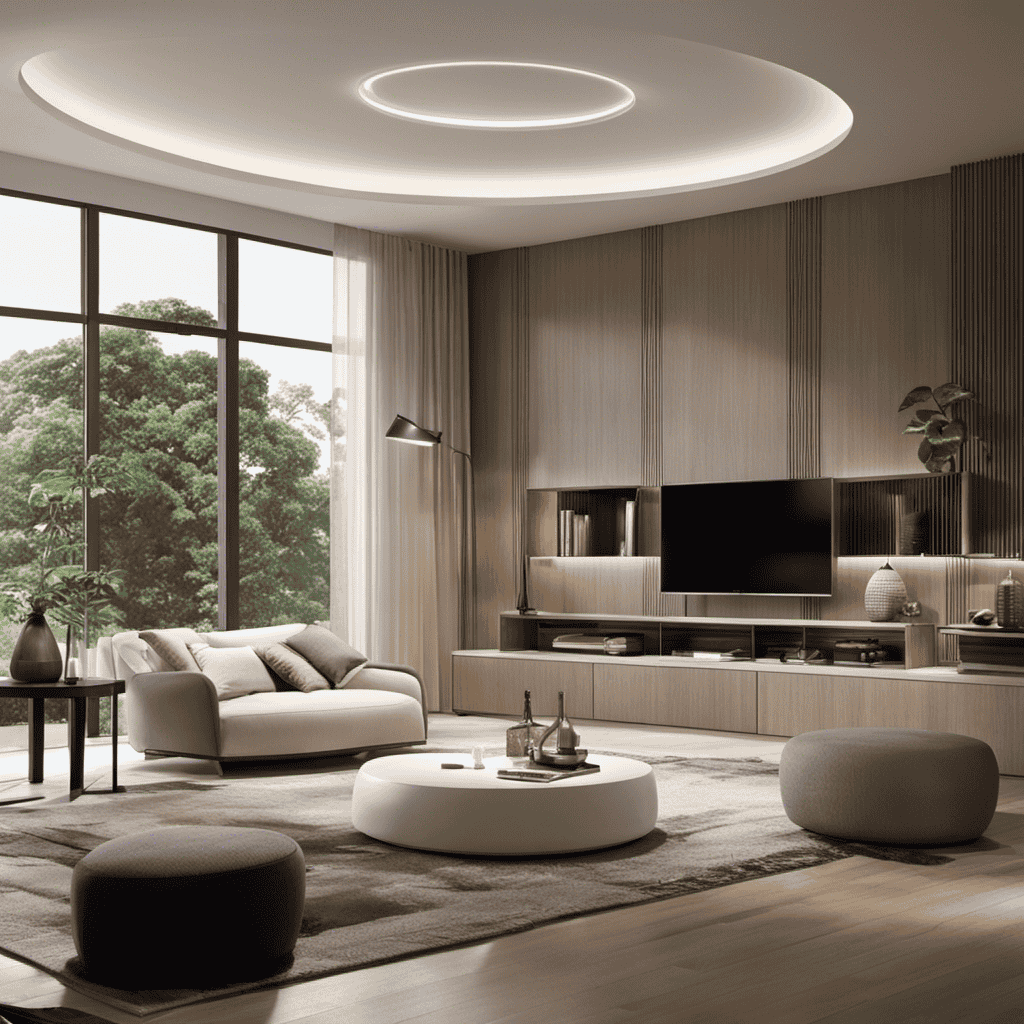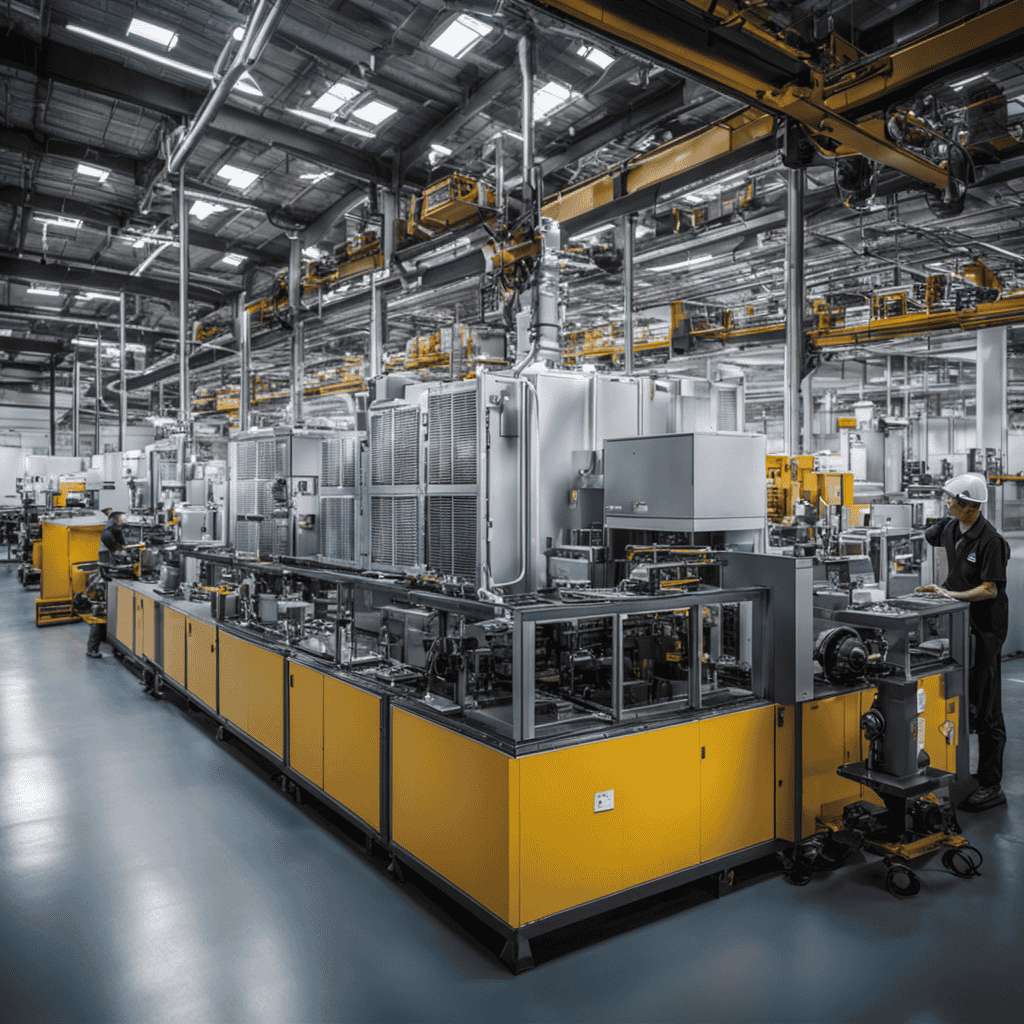As the old adage suggests, ‘Cleanliness is akin to godliness.’ In our quest for a cleaner and healthier living space, we frequently rely on devices designed to help us realize this aspiration.
Two popular options are dehumidifiers and air purifiers. But which one works better? In this article, I will objectively analyze the benefits of both, examine how they work, and provide evidence-based insights to help you decide.
Let’s dive in and explore the world of dehumidifiers and air purifiers together.
Key Takeaways
- Dehumidifiers reduce moisture levels in the home, preventing mold and mildew growth, while air purifiers capture and eliminate airborne allergens.
- Air purifiers effectively eliminate pet odors and smoke smells in indoor environments, using activated carbon filters and ozone generators.
- Both dehumidifiers and air purifiers contribute to improved indoor air quality, reducing allergens and promoting overall well-being.
- Dehumidifiers remove moisture through condensation, absorption, and ventilation, while air purifiers use advanced filtration and technology enhancement to capture and remove airborne contaminants.
Benefits of a Dehumidifier
Dehumidifiers are great because they help reduce moisture levels in your home, preventing mold and mildew growth. The benefits of using a dehumidifier are numerous.
Firstly, it improves indoor air quality by eliminating excess moisture, which can lead to the growth of harmful allergens and bacteria. This is especially important for individuals with respiratory conditions such as asthma or allergies.
Secondly, dehumidifiers are effective at reducing musty odors that can develop in damp environments. By removing excess moisture from the air, dehumidifiers create a fresher and more pleasant living space.
Additionally, dehumidifiers can help protect your home from damage caused by excessive moisture, such as warped wood, peeling paint, and damaged furniture.
Advantages of an Air Purifier
When it comes to improving indoor air quality, an air purifier is a valuable tool.
One key advantage is its ability to remove airborne allergens, such as pollen, dust mites, and pet dander, from the air.
Additionally, air purifiers are effective in eliminating odors, making them a great solution for households with pets or smokers.
Overall, investing in an air purifier can lead to a healthier and more comfortable living environment.
Airborne Allergen Removal
To effectively remove airborne allergens, you’ll want to consider using an air purifier rather than relying solely on dehumidifiers.
While dehumidifiers are effective in reducing moisture levels, they do not address the issue of airborne pollutants, such as pollen, dust mites, and pet dander.
Air purifiers, on the other hand, are specifically designed to capture and eliminate these allergens from the air. According to experts, the best practices for reducing allergens involve a combination of strategies, including using high-efficiency particulate air (HEPA) filters in air purifiers.
HEPA filters are capable of trapping particles as small as 0.3 microns, effectively removing most airborne allergens.
Additionally, regularly cleaning and maintaining the air purifier, as well as keeping doors and windows closed, can further enhance its effectiveness in controlling airborne pollutants.
Odor Elimination Capabilities
Using an air purifier can effectively eliminate odors in your home. When it comes to eliminating pet odors and removing smoke smells, air purifiers are a reliable solution.
These devices work by using filters to trap and remove particles and odors from the air. Specifically, activated carbon filters are highly effective in absorbing and neutralizing odorous molecules, such as those produced by pets or smoke. Scientific studies have shown that air purifiers with activated carbon filters can significantly reduce pet odors and smoke smells in indoor environments.
Additionally, some air purifiers also feature ozone generators, which help break down and neutralize odors at a molecular level.
Therefore, if you are looking to eliminate unpleasant odors in your home, investing in an air purifier with activated carbon filters is a wise choice.
Improved Indoor Air Quality
By improving your indoor air quality, you can create a healthier living environment for you and your family. Here are some key elements to consider when aiming for optimal humidity levels and the benefits of clean air:
-
Humidity Control: Maintaining optimal humidity levels is essential for a healthy indoor environment. Excessive moisture can lead to mold growth and respiratory issues, while low humidity can cause dryness and discomfort.
-
Reduced Allergens: Clean air helps to reduce allergens such as dust mites, pollen, and pet dander. This is especially important for individuals with allergies or asthma, as it can alleviate symptoms and improve overall respiratory health.
-
Improved Sleep: Breathing clean air during sleep can improve sleep quality and reduce sleep disturbances. Removing airborne irritants can help prevent allergies and breathing difficulties that may disrupt sleep patterns.
-
Enhanced Overall Health: Breathing in clean air can have numerous health benefits, including improved lung function, reduced risk of respiratory infections, and better overall well-being.
Understanding Humidity Levels
When it comes to our health, maintaining optimal humidity levels is crucial.
High humidity can have various negative effects on our well-being.
In this discussion, we will explore the recommended humidity levels for a healthy environment.
We will also delve into the specific effects that high humidity can have on our bodies.
Optimal Humidity for Health
To maintain optimal humidity for your health, it’s important to consider whether a dehumidifier or an air purifier would work better for you. Both devices have their benefits, but understanding their specific effects on your respiratory health is crucial. Here are some key points to consider:
-
Optimal humidity for sleep: A dehumidifier can help reduce excess moisture in the air, creating a more comfortable sleeping environment. This can prevent issues like mold growth and dust mite infestations, which can trigger allergies and respiratory problems.
-
Effects of humidity on respiratory health: High humidity levels can contribute to the growth of mold and dust mites, leading to worsened respiratory symptoms such as coughing, wheezing, and shortness of breath. An air purifier can help remove these allergens from the air, improving indoor air quality and reducing the risk of respiratory issues.
-
Personal preferences and needs: Consider your specific health concerns and living conditions when choosing between a dehumidifier and an air purifier. If you live in a humid climate or have allergies, a dehumidifier may be more beneficial. However, if you have respiratory conditions like asthma or live in a polluted area, an air purifier might be more effective in improving your health.
-
Consultation with a healthcare professional: It’s always a good idea to consult with a healthcare professional to understand your specific needs and get personalized recommendations on whether a dehumidifier or an air purifier would be more suitable for maintaining optimal humidity and promoting your respiratory health.
Effects of High Humidity
High humidity can worsen respiratory symptoms, such as coughing and wheezing, due to the growth of allergens like mold and dust mites. When the air is humid, it creates an ideal environment for these allergens to thrive and multiply. This can be especially problematic for individuals with asthma or allergies.
Research has shown that reducing humidity levels can significantly decrease the concentration of allergens in the air, leading to improved respiratory health. This is where dehumidifiers come in. Dehumidifiers work by removing excess moisture from the air, creating a drier environment that is less favorable for the growth of allergens.
How Dehumidifiers Work
Dehumidifiers work by removing excess moisture from the air. They are designed to regulate the humidity levels in indoor spaces, providing a more comfortable and healthier environment.
Here are four ways dehumidifiers remove moisture and the benefits of using them:
-
Condensation: Dehumidifiers pull in humid air, causing the moisture to condense on cold coils. This water is then collected and drained, effectively reducing humidity levels.
-
Absorption: Dehumidifiers use a desiccant material that absorbs moisture from the air, trapping it within the unit. This process helps to lower humidity and prevent the growth of mold and mildew.
-
Ventilation: Dehumidifiers also have a ventilation feature that helps to circulate air, reducing stagnant moisture and improving air quality.
-
Health benefits: By controlling humidity levels, dehumidifiers can alleviate symptoms of allergies and asthma, as well as prevent respiratory infections caused by mold and mildew.
Transitioning to the next section, air purifiers play a crucial role in maintaining indoor air quality.
The Role of Air Purifiers in Indoor Air Quality
I’ve found that air purifiers can play a significant role in improving indoor air quality. When it comes to their effectiveness, it’s important to consider factors such as the size of the room, the type of pollutants present, and the specific features of the air purifier.
The benefits of using air purifiers include reducing allergens, eliminating odors, and improving respiratory health.
There are various types of air purifiers available in the market, each with its own unique filtration method. Some examples include HEPA filters, activated carbon filters, or UV-C light technology.
Air Purifier Effectiveness
Using an air purifier can greatly improve the air quality in your home. Air purifiers are equipped with advanced filters that effectively capture and remove various airborne contaminants, such as dust, pollen, pet dander, and mold spores. The filters in air purifiers are designed to trap even the smallest particles, ensuring cleaner and healthier air for you and your family.
Additionally, air purifiers utilize advanced technology, such as HEPA filters, activated carbon filters, and UV-C light, to further enhance their effectiveness in purifying the air. These technologies work together to eliminate harmful pollutants and odors, creating a fresher and more breathable environment.
With an air purifier, you can enjoy the benefits of cleaner air, reduced allergy symptoms, and improved respiratory health.
Benefits of Air Purifiers
In the previous subtopic, we discussed the effectiveness of air purifiers. Now, let’s delve into the benefits of using air purifiers in more detail. Air purifiers offer a range of features that contribute to cleaner and healthier indoor air. Some common features include HEPA filters, activated carbon filters, and UV germicidal lamps. These features help to capture and eliminate various pollutants such as dust, pollen, pet dander, smoke, and even harmful bacteria and viruses. Additionally, air purifiers can help to reduce odors and improve overall air quality.
To further understand the benefits of air purifiers, let’s take a look at the following table:
| Benefits of Air Purifiers |
|---|
| Removes allergens |
| Eliminates odors |
| Reduces airborne pollutants |
| Improves indoor air quality |
| Helps with respiratory issues |
| Lowers the risk of respiratory infections |
Maintaining an air purifier is relatively simple. Regularly changing the filters and cleaning the unit’s exterior are essential for optimal performance. It is recommended to follow the manufacturer’s guidelines for maintenance. By incorporating an air purifier into your home or office, you can enjoy cleaner air and experience the numerous benefits it offers.
Types of Air Purifiers?
To understand the different types of air purifiers, you should explore options such as HEPA filters, activated carbon filters, and UV germicidal lamps. Each of these technologies offers unique benefits for improving indoor air quality. Here are some key features of these air purifier technologies:
-
HEPA filters: Highly effective in removing airborne particles, such as dust, pollen, and pet dander. They can capture particles as small as 0.3 microns with an efficiency of 99.97%.
-
Activated carbon filters: Ideal for removing odors, gases, and volatile organic compounds (VOCs). The porous structure of activated carbon helps trap and absorb these pollutants.
-
UV germicidal lamps: Utilize ultraviolet light to destroy bacteria, viruses, and mold spores. They are particularly effective in preventing the spread of airborne pathogens.
-
Electrostatic precipitators: Use an electrical charge to attract and trap particles. They are effective in removing larger particles but may produce ozone as a byproduct.
When it comes to air purifier maintenance, here are some essential tips:
- Regularly clean or replace filters according to the manufacturer’s instructions.
- Keep the air purifier in a well-ventilated area and away from walls or furniture to allow for proper airflow.
- Clean the unit’s exterior regularly to prevent the buildup of dust and dirt.
- Monitor the air quality in your home using a separate device or by following the air purifier’s indicator lights.
Types of Dehumidifiers
Dehumidifiers come in different types, so it’s important to choose the right one for your needs. There are three main types of dehumidifiers: refrigerative, desiccant, and electronic. Each type has its own benefits and drawbacks.
To help you understand the differences, here’s a comparison table:
| Type | Pros | Cons |
|---|---|---|
| Refrigerative | Efficient at removing moisture, suitable for larger spaces | High energy consumption |
| Desiccant | Quiet operation, effective in colder temperatures | Slower dehumidification process |
| Electronic | Energy efficient, low noise levels | May not be as effective in extremely humid conditions |
When deciding between a dehumidifier and an air purifier, it’s important to consider your specific needs. While both can improve indoor air quality, they serve different purposes. A dehumidifier primarily focuses on reducing humidity levels and preventing mold and mildew growth, while an air purifier removes airborne contaminants such as dust, pollen, and pet dander. Depending on your specific concerns, you may need one or both devices to achieve optimal air quality in your home.
Different Types of Air Purifiers
Now that we’ve discussed the different types of dehumidifiers, let’s shift our focus to the various types of air purifiers available. When it comes to improving indoor air quality, there are several brands and models to choose from. Here are some options to consider:
- HEPA air purifiers: These use high-efficiency particulate air filters to trap and remove small particles from the air.
- Activated carbon air purifiers: These are effective at removing odors and gases from the air.
- UV air purifiers: These use ultraviolet light to kill bacteria and viruses in the air.
- Ionic air purifiers: These emit negative ions to attract and trap particles in the air.
Each type of air purifier has its own set of pros and cons, depending on your specific needs.
Now, let’s explore how to choose the right dehumidifier for your needs.
Choosing the Right Dehumidifier for Your Needs
If you’re looking to improve the quality of your indoor environment, consider exploring the different types of air purifiers available.
However, if excess moisture is a concern in your home, a dehumidifier might be a more appropriate choice.
When choosing the right dehumidifier for your needs, there are a few factors to consider.
First, assess the size of the area you want to dehumidify, as this will determine the capacity you require.
Next, consider the humidity level in your space and choose a dehumidifier with the appropriate moisture removal rate.
Additionally, look for features like automatic shut-off and adjustable humidity settings for convenience.
It is also important to regularly maintain and clean your dehumidifier to ensure its optimal performance.
This includes emptying and cleaning the water tank, washing or replacing filters, and checking for any signs of damage or malfunction.
Selecting the Best Air Purifier for Your Home
When it comes to improving the air quality in your home, you may want to consider exploring the different types of air purifiers available. Air purifiers are designed to remove contaminants from the air, creating a cleaner and healthier environment for you and your family.
Here are some important features to consider when selecting an air purifier:
-
HEPA filtration: High Efficiency Particulate Air (HEPA) filters are known for their ability to capture 99.97% of particles as small as 0.3 microns, including dust, pollen, and pet dander.
-
Activated carbon filters: These filters are effective at trapping odors, chemicals, and volatile organic compounds (VOCs), improving the overall air quality.
-
UV-C light technology: Ultraviolet-C light can help eliminate airborne bacteria, viruses, and mold spores, reducing the risk of respiratory infections.
-
Noise level: Look for air purifiers with low noise levels, especially if you plan on using them in bedrooms or other quiet spaces.
In terms of maintenance, air purifiers generally require regular filter changes to ensure optimal performance. It’s important to follow the manufacturer’s instructions for filter replacement and cleaning to keep your air purifier functioning effectively.
Comparing Dehumidifiers and Air Purifiers
Consider exploring the benefits of using a dehumidifier in addition to an air purifier in your home.
Both dehumidifiers and air purifiers play important roles in improving indoor air quality and creating a healthier living environment.
While air purifiers are effective at removing airborne particles such as dust, pollen, and pet dander, dehumidifiers are specifically designed to control humidity levels.
High humidity can promote the growth of mold, mildew, and other indoor air pollutants.
By reducing excess moisture in the air, dehumidifiers help prevent the growth of these harmful substances, thus improving the overall air quality in your home.
Combining the use of both dehumidifiers and air purifiers can provide a comprehensive approach to maintaining clean and healthy indoor air.
Now, let’s explore some tips for maintaining and cleaning dehumidifiers and air purifiers.
Tips for Maintaining and Cleaning Dehumidifiers and Air Purifiers
To keep your dehumidifier and air purifier running efficiently, make sure to regularly clean and maintain them. Here are some cleaning techniques and maintenance tips to ensure optimal performance:
-
Clean the filters: Dirty filters can restrict airflow and reduce the effectiveness of your appliances. Clean or replace the filters according to the manufacturer’s instructions.
-
Empty the water tank: Dehumidifiers collect moisture, which accumulates in a water tank. Regularly emptying the tank prevents mold and bacteria growth.
-
Wipe down the surfaces: Dust and debris can accumulate on the surfaces of your dehumidifier and air purifier. Use a damp cloth to wipe them down regularly.
-
Check for leaks and damage: Inspect your appliances for any leaks or damage that may affect their performance. Address any issues promptly to prevent further damage.
Conclusion
In conclusion, both dehumidifiers and air purifiers play important roles in improving indoor air quality.
Dehumidifiers are effective in reducing moisture levels and preventing mold growth.
Air purifiers, on the other hand, are designed to remove airborne pollutants and allergens.
Interestingly, a study conducted by the EPA found that indoor air can be up to five times more polluted than outdoor air.
This statistic emphasizes the need for both dehumidifiers and air purifiers to create a healthy and clean living environment.
By understanding the benefits and functioning of these devices, individuals can make informed decisions to maintain optimal indoor air quality.










